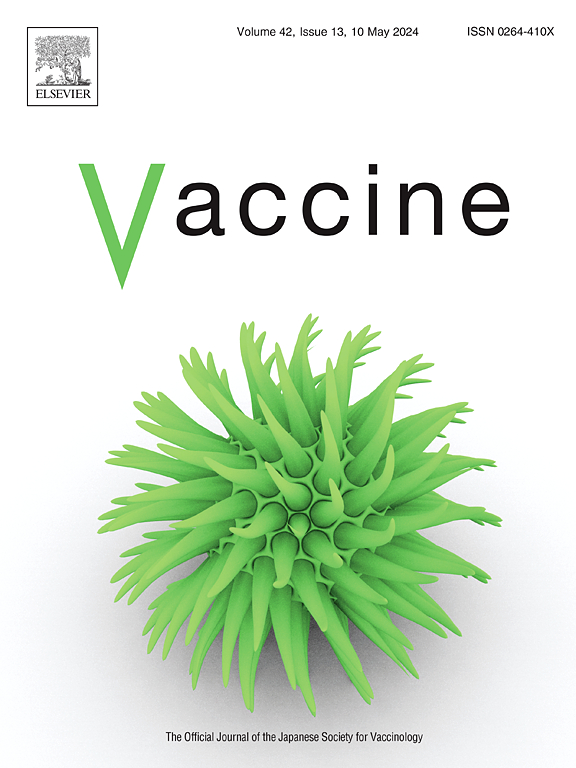Assessing effects of pneumococcal vaccination (PCV13) and rotavirus vaccination (RV) on colonization with extended-spectrum cephalosporin-resistant Enterobacterales (ESCrE) in Guatemalan children
IF 4.5
3区 医学
Q2 IMMUNOLOGY
引用次数: 0
Abstract
Background
We aimed to determine if vaccination against rotavirus (RV) or pneumococcus (PCV13) is associated with reduced colonization with extended-spectrum cephalosporin-resistant Enterobacterales (ESCrE) in children (<15 years) living in Guatemala.
Methods
Questionnaire information, vaccine records, and stool samples were collected from enrolled participants. Specimens were plated onto selective media with antibiotic susceptibility confirmed using a VITEK®2. We employed an instrumental variables approach with maximum likelihood for a system of three nested probit regression equations for binary outcomes of RV or PCV13 vaccination, diarrhea or clinic visits, and ESCrE colonization.
Results
Participants (n = 406) ranged from 0 to 14 years old, 123 (30.3 %) were 0–2 years old, 103 (25.4 %) were 3–5 years old, and 180 (44.3 %) were 6–14 years old. PCV13 vaccination had indirect negative effects on ESCrE colonization (−0.092, P < 0.01) mediated through clinic visits (−0.461, P < 0.01), while antibiotic use had a direct positive effect on clinic visits (0.226, P < 0.01), but no significant effects on ESCrE colonization. Effects of RV on ESCrE colonization were inconclusive likely due to the limited sample size of RV-unvaccinated children. Protective effects of yogurt consumption on ESCrE colonization (−0.064, P < 0.01; −0.062, P < 0.01) and positive direct effects of land used for agriculture (0.232, P < 0.01; 0.224, P 〈001) were detected in both RV and PCV13 models, respectively. Report of diarrhea in the past 30 days had a direct positive effect on colonization (0.731, P < 0.01) in the RV model, and indirect positive effects on ESCrE colonization (0.090, P < 0.01) in the PCV13 model.
Interpretation
Vaccination for pneumococcal disease was associated with a reduction in colonization with ESCrE bacteria. Antibiotic use did not contribute directly or indirectly to ESCrE colonization. These findings should be confirmed through studies designed to collect clinical outcomes data. Findings from this and other studies suggest that ESCrE colonization is mediated by a complex interplay of factors.
评估危地马拉儿童肺炎球菌疫苗接种(PCV13)和轮状病毒疫苗接种(RV)对广谱头孢菌素耐药肠杆菌(ESCrE)定植的影响
背景:我们的目的是确定接种轮状病毒(RV)或肺炎球菌(PCV13)是否与儿童中广谱头孢菌素耐药肠杆菌(ESCrE)定植减少有关(方法:收集调查问卷信息、疫苗记录和粪便样本)。将标本镀于选择性培养基上,并使用VITEK®2进行抗生素敏感性鉴定。我们采用了工具变量方法,对三个嵌套概率回归方程的系统进行了最大似然分析,以确定RV或PCV13疫苗接种、腹泻或就诊以及ESCrE定植的二元结果。结果:参与者(n = 406)年龄在0 ~ 14岁之间,0 ~ 2岁123人(30.3%),3 ~ 5岁103人(25.4%),6 ~ 14岁180人(44.3%)。PCV13疫苗接种对ESCrE定植有间接的负面影响(-0.092,P)。解释:肺炎球菌疾病疫苗接种与ESCrE细菌定植减少有关。抗生素的使用对ESCrE的定植没有直接或间接的影响。这些发现应该通过收集临床结果数据的研究来证实。这项研究和其他研究的结果表明,ESCrE的定植是由一系列复杂的因素相互作用介导的。
本文章由计算机程序翻译,如有差异,请以英文原文为准。
求助全文
约1分钟内获得全文
求助全文
来源期刊

Vaccine
医学-免疫学
CiteScore
8.70
自引率
5.50%
发文量
992
审稿时长
131 days
期刊介绍:
Vaccine is unique in publishing the highest quality science across all disciplines relevant to the field of vaccinology - all original article submissions across basic and clinical research, vaccine manufacturing, history, public policy, behavioral science and ethics, social sciences, safety, and many other related areas are welcomed. The submission categories as given in the Guide for Authors indicate where we receive the most papers. Papers outside these major areas are also welcome and authors are encouraged to contact us with specific questions.
 求助内容:
求助内容: 应助结果提醒方式:
应助结果提醒方式:


